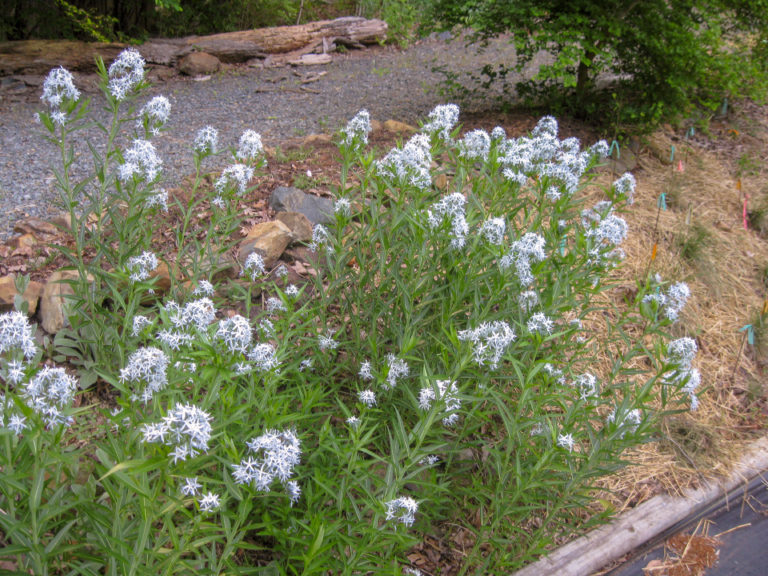Eastern Bluestar, or Willow Amsonia, is a showy, dependably beautiful, clump-forming hardy perennial about three feet in height and spread. The leaves are shiny, medium-green and willow-shaped, and can turn yellow in the fall. The flowers of Eastern Bluestar are a bright unusual blue color. They are star-shaped, and borne in loose panicles on the ends of the erect stems, making Eastern Bluestar a good cut flower for arrangements. The flowers are replaced by long, narrow cylindrical pods in fall. Although a low-maintenance plant, Amsonia should be cut back after flowering to control its height especially if grown in less than full sun. Eastern Bluestar is native to the Eastern U.S. from Texas to New York. In NC, it is found mostly but not exclusively in Piedmont counties.
NURSERY HOURS
Wednesday: 10-4 Thursday: 10-6 Friday-Saturday: 10-4 Sunday: 12-4
Amsonia tabernaemontana

Key Info
Scientific Name: Amsonia tabernaemontana Walter
Common Names: Bluestar, Willow Bluestar, Eastern Bluestar, Woodland Bluestar, Willow Amsonia
Family Names: Apocynaceae (Dogbane Family)
Plant Type: Herbaceous perennial
Flower Color: Blue
Special Characteristics: Attracts bees Attracts butterflies Attracts hummingbirds Deer resistant
Additional Info
Habit: Erect, clump-forming, branched perennial with a tap root.
Height: 2-3'
Spread: 2-3'
Soil Conditions: Tolerates a range of soils from sandy to clay; prefers moisture-retaining organic soil, pH slightly acidic.
Leaves: Alternate, narrowly ovate, 6" long, entire margins, bright green above, paler beneath. May be yellow in fall.
Flowers (or reproductive structures: Blue, tubular corolla which expands into a star shape, clustered in compact panicles at the end of the erect stems; unscented.
Fruit: cylindrical follicles or seed pods 4-5" long, 2 per flower, ripe in fall
Natural Distribution: Rcky woodlands, shaded ravines, wet, sandy sites
USDA Hardiness Zone: 3 to 9
USDA Wetland Indicator Status in NC: FACW
Pollination: Nectar attracts Ruby Throated Hummingbirds and long-tongued insects: carpenter bees, hummingbird moths, butterflies
Wildlife Connections: The flowers attract hummingbirds and long-tongued insects such as Carpenter Bees and Hummingbird moths and butterflies such as the Coral Hairstreak butterfly. Due to the somewhat toxic nature of this plant’s latex, insect pests and mammals tend to stay away.
Propagation: By division (spring or fall); by cuttings, or from seed.
